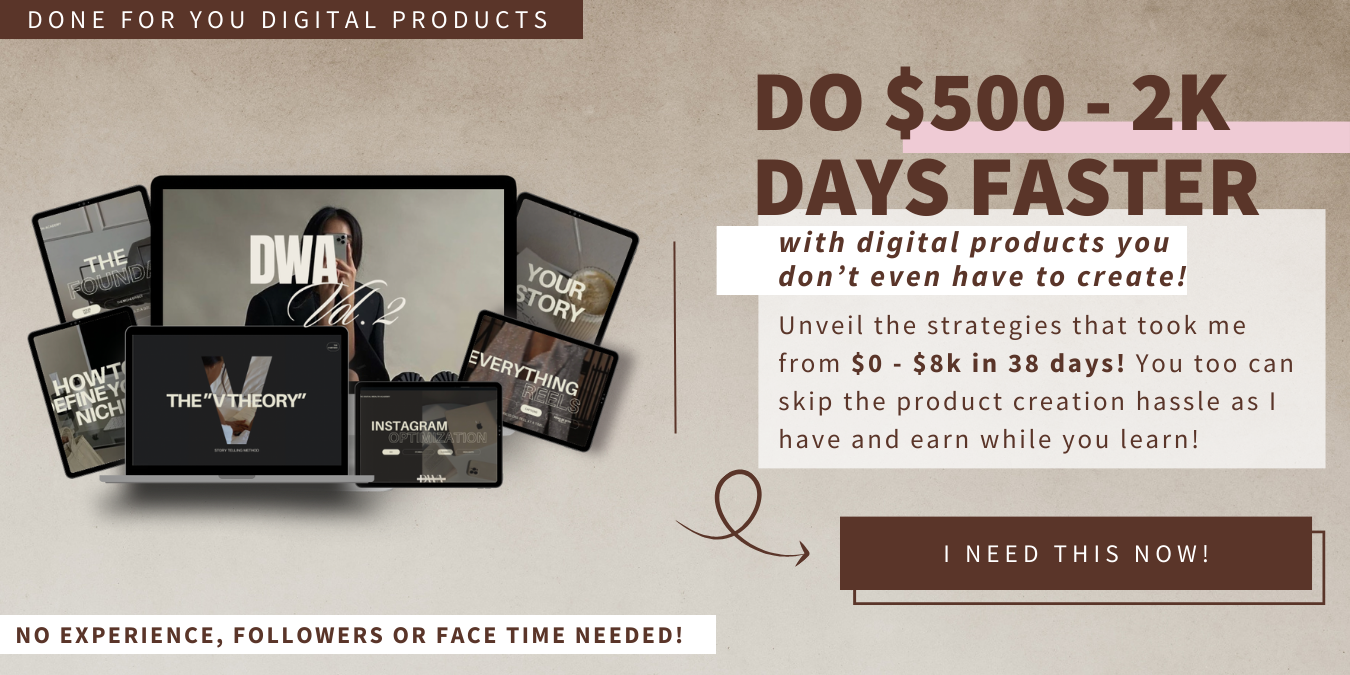Before you can start learning how to market digital products, it’s crucial to fully understand what they are and their scope.
What are Digital Products?
Digital products are goods that exist in a digital format and are sold online. Unlike physical products, they don’t require shipping or handling and can be delivered to customers instantly via the internet. Types of digital products include eBooks, online courses, music, digital art, software and more.
Digital products provide a way for entrepreneurs to share their knowledge, creativity and expertise with a global audience. They are an attractive business model because they often require less upfront investment than physical products and can generate passive income. Check out this article for more digital products ideas.
The Scope of Digital Products
The scope of digital products is vast and constantly evolving. Here are a few categories and examples that provide an idea of the range of possibilities:
| Category | Examples |
|---|---|
| Information Products | eBooks, online courses, webinars |
| Software | Apps, plugins, digital tools |
| Media | Music, podcasts, videos |
| Graphics & Design | Stock photos, templates, digital art |
For instance, if you’re an expert in a certain field, you could create an eBook or an online course to share your knowledge. If you’re a musician, you could sell your music online. If you’re a graphic designer, you could sell your designs as digital art, templates or stock photos.
The potential for creating and selling digital products is only limited by your imagination and skills. Whether you’re interested in selling digital products on a platform like Etsy (digital products to sell on Etsy) or you’re looking for the best website to sell digital products (best website to sell digital products), there’s a wealth of opportunity to explore.
Understanding what digital products are and their scope is the first step in learning how to market them effectively. As you delve deeper into this exciting world, you’ll discover a host of strategies and tools that can help you succeed in the digital marketplace.

The Importance of Marketing for Digital Products
As you venture into the world of digital products, one thing becomes clear: having a great product is only half the battle. The other half? Getting it in front of the right audience. That’s where marketing comes in.
Why Marketing Matters
Marketing, especially for digital products, is not just an optional extra—it’s a necessity. Why? Because no matter how amazing your digital product is, it won’t sell itself. People need to know it exists before they can consider buying it.
Effective marketing raises awareness of your product, highlights its unique selling points and convinces potential customers of its value. Without marketing, even the best digital products might get lost in the vast sea of online offerings.
Consider this: You’re an entrepreneur who’s created a fantastic ebook or an ingenious online course. Yet, if you don’t market them well, they’ll be like a needle in a haystack—difficult to find among the thousands of other similar products available online.
So, whether you’re selling ebooks, planners or any other digital products, marketing should be a key part of your strategy. Not sure where to start? Check out my guide on how to sell digital products.
Challenges in Marketing Digital Products
While crucial, marketing digital products does come with its own set of challenges. For one, digital products are intangible. You’re not selling a physical item that people can touch, taste or try on. You’re selling a file, access to a platform or a digital experience. This intangibility can make it harder to convey the value of your product to potential customers.
Another challenge is the sheer volume of digital products available online. The digital marketplace is crowded and standing out requires creativity, strategy and persistence. This why it can help to be a brown pigeon.
Furthermore, customer expectations are high. There are likely dozens, if not hundreds, of similar products out there. To convince someone to choose yours, you need to clearly communicate what sets your product apart and why it’s worth the investment.
Despite these challenges, remember: effective marketing is not just possible, it’s achievable. With the right strategy, you can overcome these hurdles and successfully market your digital products. After all, every challenge is an opportunity in disguise and with the right approach, you can turn these obstacles into stepping stones for success.
So, are you ready to learn how to market digital products like a pro? Let’s dive in!

How to Market Digital Products
Once you’ve created your digital products, the next step is to market them effectively. Here are some strategies to help you promote your digital products like a pro.
Understanding Your Target Audience
Before you can effectively market your digital products, you need to understand who your target audience is. Ask yourself, who would be interested in your products? What are their needs, interests and pain points? What are their online habits? Knowing your audience will allow you to tailor your marketing strategies to resonate with them and meet their needs.
You can gather information about your target audience through market research, customer surveys and analyzing your website and social media analytics. Once you have a clear understanding of your audience, you can create customer personas to guide your marketing efforts.
| Customer Persona | Needs | Interests | Online Habits |
|---|---|---|---|
| Busy Mom | Time-saving solutions, Practical products, Easy-to-use | Family, Health, Convenience | Social media, Online shopping |
| Freelancer | Flexible solutions, Cost-effective products, Learning resources | Work, Learning, Productivity | Blogs, Webinars, Online courses |
Building a Strong Online Presence
Building a strong online presence is key to marketing your digital products. This means having a well-designed website, active social media profiles and a blog with valuable content related to your products. Consider where your target audience spends their time online and make sure your brand is visible and engaging on those platforms.
Your website is your online storefront, so make sure it’s user-friendly, visually appealing and easy to navigate. Include detailed descriptions of your digital products, customer testimonials and a FAQ section to address potential questions or concerns. If you need inspiration, check out my list of the best websites to sell digital products.
Social media is a powerful tool for reaching and engaging with your target audience. Regularly post engaging content, respond to comments and messages and use relevant hashtags to increase your visibility.
Using SEO to Your Advantage
Search engine optimization (SEO) is a crucial strategy for driving organic traffic to your website. By optimizing your website and content with relevant keywords, you’ll increase your chances of appearing in search engine results when potential customers are looking for products like yours.
Start by identifying keywords related to your digital products. These could be the names of your products, related topics or common questions your target audience might ask. Then incorporate these keywords into your website content, blog posts and product descriptions.
Additionally, consider creating SEO-friendly content that provides value to your audience and showcases your expertise. For example, if you sell digital planners, you could write a blog post on how to sell planners online. This not only positions you as an expert in your field but also helps to draw in potential customers through search engine results.
Remember, SEO is a long-term strategy that requires consistent effort. But when done right, it can significantly boost your visibility online and increase your digital product sales.
By understanding your target audience, building a strong online presence and leveraging SEO, you’ll be well on your way to marketing your digital products effectively. Keep testing and refining your strategies to find what works best for your unique products and audience. Happy marketing!
Social Media Marketing
Harnessing the power of social media platforms can prove to be a game-changer in your quest to market digital products successfully. Let’s dive into the crucial role social media can play in your marketing efforts and tips to use it effectively.
The Role of Social Media
In today’s digital era, social media has become a powerful tool for businesses of all sizes. It offers an interactive platform where you can showcase your digital products, engage with your audience and build strong relationships with potential customers.
Given the vast user base of popular social platforms, it helps you reach a broad audience, increasing the visibility of your digital products. Whether you’re selling eBooks, online courses or planners, social media can be instrumental in driving traffic to your website or online store.
Moreover, social media allows you to gain insights into your audience’s preferences and behaviors, helping you understand what resonates with them. This knowledge can inform your marketing strategy and help you tailor your digital products to meet your audience’s needs.
Tips for Effective Social Media Marketing
- Define Your Goals: Whether it’s increasing brand awareness, driving traffic to your website or boosting sales, clearly defined goals will guide your social media marketing strategy.
- Know Your Audience: Understanding who your ideal customers are and what they want is key to creating content that resonates with them.
- Choose the Right Platforms: Not all social media platforms are created equal. Depending on your target audience and the nature of your digital products, certain platforms may be more effective than others. For instance, if you’re selling digital products on Etsy, platforms like Pinterest and Instagram might be more suitable.
- Create Engaging Content: Content is king, even on social media. Create posts that inform, entertain and engage your audience. This could be sneak peeks of your upcoming digital products, user testimonials or helpful tips related to your product niche.
- Engage with Your Audience: Respond to comments, answer questions and interact with your audience regularly. This helps build a sense of community and shows your audience that you value their input.
- Use Hashtags Strategically: Hashtags can help increase the visibility of your posts. Use relevant hashtags that your target audience is likely to follow.
- Monitor and Adjust: Keep an eye on your social media analytics to understand what’s working and what’s not. Use this information to adjust your strategy and improve your results.
Social media marketing, when done right, can significantly boost your digital product sales. Remember, it’s not about being present on all platforms, but about mastering the ones where your target audience spends their time. For more tips on how to market digital products, check out my guide on how to sell digital products.
Email Marketing
Email marketing is a vital component of any strategy on how to market digital products. Let’s delve into why it’s so important and how you can craft effective emails.
Why Email Marketing?
Email marketing is a direct and personal way to reach your audience. By landing in your potential customer’s inbox, you’re able to communicate in a space they check regularly. Here’s why you should be considering it:
- High Reach: Email allows you to reach a wide audience quickly and efficiently.
- Cost-Effective: It’s one of the most affordable marketing strategies out there.
- Personalized Approach: Email enables you to tailor your message to each recipient, increasing relevancy and engagement.
- Measurable Results: With email marketing, you can track open rates, click-through rates and conversions, giving you valuable insights.
Email marketing is an excellent tool, especially when you’re determining how to sell digital products effectively.
How to Craft Effective Emails
Crafting effective emails is an art that requires a good understanding of your audience and a clear strategy. Here’s how to get started:
- Subject Line: Your subject line should be compelling and inspire curiosity, prompting the recipient to open the email.
- Personalization: Personalize your emails by including the recipient’s name and tailoring the content to their interests or past behavior.
- Clear and Concise Content: Keep your content clear, concise and focused on the main message. Use bullet points or short paragraphs to make it easy to read.
- Strong Call-to-Action: Include a strong call-to-action that clearly tells the reader what to do next.
- Visual Appeal: Use visuals like images or infographics to make your email more appealing and easier to digest.
| Elements | Description |
|---|---|
| Subject Line | Compelling and inspires curiosity |
| Personalization | Includes recipient’s name and tailored content |
| Clear and Concise Content | Content is focused and easy to read |
| Strong Call-to-Action | Clearly tells the reader what to do next |
| Visual Appeal | Uses visuals to enhance appeal and comprehension |
Remember, email marketing is not just about selling. It’s also a great way to build relationships with your audience by providing them with valuable content. Whether it’s a useful blog post, a free ebook or a special discount, providing value can go a long way in fostering loyalty and driving sales of your digital products.
Whether you’re selling ebooks, planners or any other type of digital product, email marketing can be a powerful tool in your marketing arsenal. With a well-crafted strategy, you can use email to reach more customers, build strong relationships and ultimately boost your sales.
Content Marketing
When it comes to learning how to market digital products, understanding the power of content marketing is crucial. This strategy can help you engage your target audience, build brand awareness and drive product sales.
The Power of Content
Content marketing is all about creating and sharing valuable content that provides relevant information, solves problems or entertains your audience. This can help you establish your brand as an authority in your market, build trust with your audience and encourage them to engage with your brand.
Content can take many forms, from blog posts and articles to videos, ebooks and infographics. For example, if you’re selling digital products such as ebooks, you could create a blog post on how to sell ebooks without any experience, providing valuable tips and insights to your readers.
The key to content marketing is to ensure that your content is useful and relevant to your audience. This will make them more likely to share it, expand your reach and attract more potential customers to your brand.
Tips for Effective Content Marketing
- Understand Your Audience: Before you start creating content, it’s important to understand who your audience is and what they are interested in. This will help you create content that resonates with them and meets their needs.
- Create Quality Content: Quality is more important than quantity in content marketing. Focus on creating content that is well-researched, well-written and provides real value to your audience.
- Use SEO: Incorporate SEO techniques into your content to improve its visibility in search engine results. This includes using relevant keywords, optimizing your meta tags and images and creating high-quality backlinks.
- Promote Your Content: Once you’ve created your content, don’t forget to promote it. Share it on your social media channels, email it to your subscribers and use other promotional strategies to get it in front of as many people as possible.
- Measure Your Success: Use analytics tools to track the success of your content marketing efforts. This can help you understand what’s working, what’s not and how you can improve your strategy.
Content marketing is a powerful tool in your digital products marketing arsenal. By creating and sharing valuable content, you can attract, engage and convert your target audience, helping you sell more digital products and grow your business. For more tips on selling digital products, check out my articles on where to sell digital products and best website to sell digital products.
Paid Advertising
In your journey to learn how to market digital products, you’ll eventually come across a powerful strategy: paid advertising. It’s an essential tool in your digital marketing arsenal that can significantly boost your product’s visibility and reach.
Understanding Paid Advertising
Paid advertising refers to any kind of marketing strategy where you pay to place your ads on various platforms. These platforms can range from search engines like Google to social media networks like Facebook and Instagram. By paying for ad space, you can showcase your digital products to a larger and more targeted audience, increasing your chances of making a sale.
The cost of paid advertising can vary widely depending on the platform you choose and the competition for your target keywords. You can typically set a budget that suits your needs, making it a versatile strategy that can be tailored to businesses of all sizes.
Here’s a quick overview of the typical cost per click (CPC) on some popular advertising platforms:
| Advertising Platform | Average CPC |
|---|---|
| Google Ads | $1 – $2 |
| Facebook Ads | $0.50 – $2 |
| Instagram Ads | $0.50 – $1 |
| LinkedIn Ads | $5 – $8 |
Remember, these are just averages. The actual cost can vary depending on your industry, competition and the specific keywords you’re targeting.
When to Use Paid Advertising
Paid advertising can be a great way to boost your digital product sales, but it’s not always the right choice for every situation. Here are a few scenarios where paid advertising could be a good fit:
- You’re launching a new product: When you’re introducing a new digital product to the market, paid advertising can help you generate buzz and attract early customers.
- You’re in a highly competitive market: If you’re selling digital products in a crowded market, paid advertising can help your products stand out from the competition.
- You want to target a specific audience: With paid advertising, you can target your ads to a specific demographic, ensuring that your products are seen by the people most likely to be interested.
- You want to see results quickly: Unlike SEO and content marketing, which can take time to yield results, paid advertising can deliver immediate traffic and conversions.
Remember, while paid advertising can be effective, it’s not a standalone solution. It should be used as part of a broader digital marketing strategy that includes other tactics like SEO, content marketing and social media marketing.
So, are you ready to dive into paid advertising and take your digital product sales to the next level? If so, start planning your strategy now and don’t hesitate to experiment with different platforms and techniques. Every business is unique and what works for others might not work for you. It’s all about finding the right approach that suits your business goals and budget. Good luck!
Analytics and Feedback
In your journey to learn how to market digital products, analytics and feedback become your compass and map. They allow you to measure progress, identify areas of improvement and refine your strategies.
Tracking Your Success
It’s essential to set clear, measurable goals for your marketing efforts. Then, you can use various analytics tools to track your progress towards these goals. Metrics such as website traffic, social media engagement, email open rates and conversion rates are crucial indicators of how well your marketing strategies are working.
For example, if one of your goals is to increase website traffic by 50% in three months, you could track your progress using a table like this:
| Month | Website Traffic | % Increase |
|---|---|---|
| January | 1,000 | – |
| February | 1,300 | 30% |
| March | 1,600 | 50% |
These numbers help you see if you’re on track to meet your goal or if you need to adjust your strategies.
Using Feedback to Improve Your Marketing
While analytics give you hard data, feedback provides qualitative insights into how your audience perceives your digital products and marketing efforts. This can be gleaned from customer reviews, social media comments and direct feedback through emails or contact forms.
Feedback is a goldmine of information that can help you understand what your customers like or dislike about your products or marketing methods. For instance, if customers mention that they love your regular email newsletters full of valuable tips, that’s a sign to continue — and perhaps even enhance — your email marketing efforts.
On the other hand, if several customers mention that they find your website hard to navigate, that’s feedback you can use to improve the user experience on your site.
Remember, the goal is not just to sell digital products but to build a loyal customer base. So take every piece of feedback as an opportunity to improve and refine your marketing strategies, making your customers feel heard and valued in the process.
By effectively using analytics and feedback, you’ll be well on your way to mastering how to market digital products. Always be ready to learn, adapt and grow then you’ll see your digital product business thrive.
For more tips and advice on selling digital products, check out some of my other articles, including how to sell ebooks without any experience and how to sell planners online.




